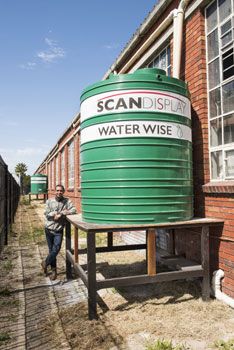
Related

Soil and water: An inseparable partnership in a changing agricultural landscape
Prof Driekie Fourie 4 Dec 2025





Top stories

LegalNigeria to implement new tax laws from January 1 despite calls for delay, Tinubu says
Camillus Eboh 1 day


In light of this, some businesses have decided to proactively find alternatives to relying on the overburdened municipal water supply – such as Scan Display, a national exhibition, events and retail display specialist.
The company has adopted various sustainable practices and technologies over the past few years. These include implementing waste recycling, procuring environmentally friendly cleaning products nationally, training staff on ‘greening’, renovating the Johannesburg and Cape Town production facilities to increase the use of natural lighting, and powering the Johannesburg office with solar panels. More recently, the Cape Town branch has implemented a rainwater harvesting system.
“It is important to us to be cognisant of our resources – whether they are abundant or scarce – in a way that is sustainable to the economic development of the province,” says Jane Steel, Sales Manager for Scan Display Cape Town. “In light of our many other greening initiatives, our commitment to using water responsibly was a natural development for us.”
Tashreeq Benjamin is a Quantity Surveyor at Scan Display Cape Town. He took on the task of finding an effective long-term water solution for the company. He explains, “We opted for rainwater harvesting instead of pumping water from a borehole for two reasons: firstly, we have a huge roof area, so we have a catchment advantage. Secondly, pumping requires energy to pull water from the ground, filter it, and then an additional booster pump is needed to send the water to its various outlets for usage. This means three pumps are needed in total. So, going for rainwater harvesting is both greener and more cost-effective than the alternative.”

Two 5,000-litre tanks are now set up to collect run-off from a 780m² section of the warehouse roof. After one tank is full, a switch is triggered to fill the second tank. The tanks connect to the building in such a way that the water is available by simply turning on a tap. The smallest possible pump is used to power the water flow throughout the building, to ensure minimal energy consumption.
“A single day with 15ml of rainfall will fill both tanks. This supplies us with enough water to use for our production requirements, cleaning and ablutions for a two-week period,” says Benjamin. “Since we’ve installed it a month ago, we have not used any municipal water.
“Rainwater harvesting is a great way to use Mother Nature to pay the bills!” he adds.
The long-term goal for the company is to become self-sufficient for all water requirements. To do this, they will install more tanks to capture water from the total roof area, which is an additional footprint of 1,560m² (double what is currently being used). And, because the roof contains asbestos, a reverse osmosis water filtration system will be installed to purify the collected rainwater so that it is safe to drink.